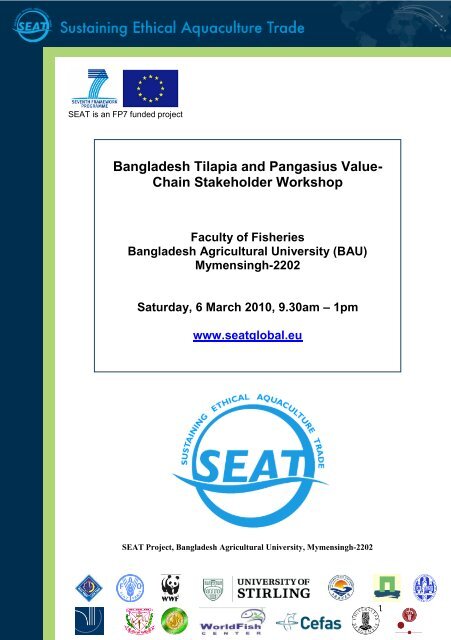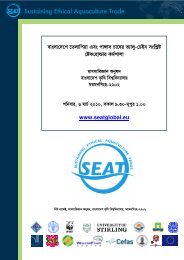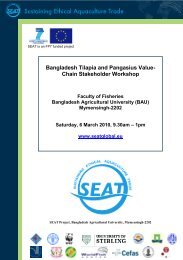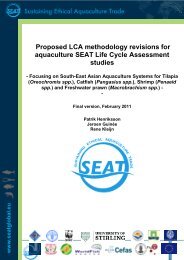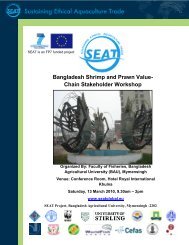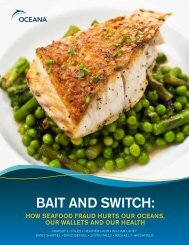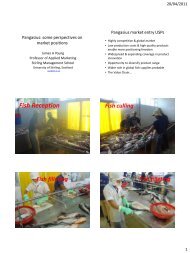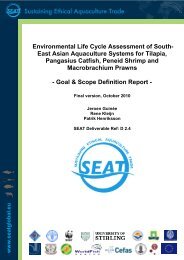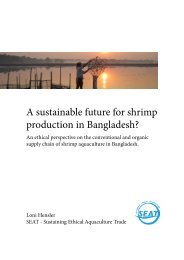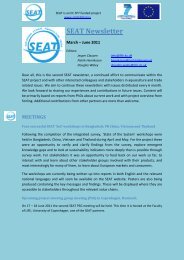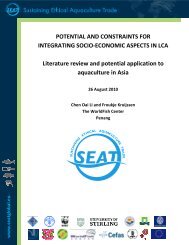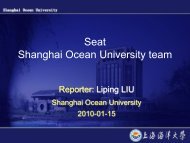English - SEAT Global
English - SEAT Global
English - SEAT Global
Create successful ePaper yourself
Turn your PDF publications into a flip-book with our unique Google optimized e-Paper software.
<strong>SEAT</strong> is an FP7 funded project<br />
Bangladesh Tilapia and Pangasius Value-<br />
Chain Stakeholder Workshop<br />
Faculty of Fisheries<br />
Bangladesh Agricultural University (BAU)<br />
Mymensingh-2202<br />
Saturday, 6 March 2010, 9.30am – 1pm<br />
www.seatglobal.eu<br />
<strong>SEAT</strong> Project, Bangladesh Agricultural University, Mymensingh-2202<br />
1
Plates 1 and 2: Introducing stakeholders to the aims of the workshop<br />
2
Contents<br />
Executive Summary 4<br />
1. Aims of the workshop 6<br />
1.1 Workshop schedule 6<br />
2. Outcomes of workshop 7<br />
2.1 <strong>SEAT</strong> introductory presentation 7<br />
2.1.1 Questions/ comments following the <strong>SEAT</strong> presentation 7<br />
2.2 Group discussions and presentations 9<br />
2.2.1 Summary of presentations 11<br />
3. Comments, Q&A session 16<br />
4. Concluding remarks 17<br />
Tables<br />
Table 1. Stakeholder groups and questions for the discussion activity –<br />
‘opportunities and constraints for development of the sector’ 10<br />
Plates<br />
Plates 1 and 2: Introduction to aims of the workshop 2<br />
Plate 3: Group discussion presentations (feed and service providers group) 10<br />
Appendices<br />
Appendix 1: List of participants, other invitees and membership of discussion<br />
groups 18<br />
Appendix 2: Introduction the <strong>SEAT</strong> project – power point presentation 23<br />
3
Executive Summary<br />
This half-day stakeholder workshop was convened by Bangladesh Agricultural<br />
University (BAU), Faculty of Fisheries, Mymensingh. BAU is a part of a consortium<br />
implementing Sustaining Ethical Aquaculture Trade (<strong>SEAT</strong>); a large-scale<br />
collaborative research project (EU FP7) investigating the sustainability of seafood<br />
trade between Asia and the EU.<br />
The main purposes of the workshop were to familiarize local stakeholders in the<br />
farmed pangasius and tilapia value chain with the aims of <strong>SEAT</strong> and secondly to<br />
identify stakeholder perceptions regarding opportunities and constraints for<br />
development of an export trade. A final purpose was to gauge potential for<br />
collaboration with small and medium enterprises (SMEs) in an action research<br />
component of the project.<br />
After an introductory presentation (Appendix 2) participants were divided into five<br />
groups to discuss constraints and opportunities. The groups were (1) research,<br />
government and NGO’s (2) feed and other service providers (3) processors and<br />
exporters (4) large commercial farms and hatcheries (5) small-farmers. No major<br />
processors or exporters attended the workshop reflecting the as yet relatively<br />
undeveloped nature of value chains for these species.<br />
Pangasius was considered to have greater export potential than tilapia. Several<br />
shrimp processors are already experimenting with fillet processing for supply to the<br />
EU and ex-Soviet block countries. This diversification is a response to substantial<br />
over-capacity in the shrimp-processing sector.<br />
Various constraints were identified. Pangasius pond farming clusters are established<br />
in four upland locations enjoying low flood risk and good road connections. However,<br />
water exchange capacity is limited with implications for water quality and accelerated<br />
sludge build-up. Consequently production intensity is very low compared to potential<br />
export-competitors such as Vietnam.<br />
Feed quality is a major constraint. There are trade-offs to be made between price,<br />
performance and reputation. For example the use of imported meat and bone meals<br />
banned for livestock use in the EU although locally acceptable, may compromise<br />
export potential.<br />
Food safety traceability is a key priority for sustainable trade. A need for a<br />
registration scheme combined with a national good aquaculture practices (GAP)<br />
certification scheme was identified. Although it was felt that this would be more<br />
straightforward than the shrimp sector, weak regulatory capacity is a major<br />
constraint. Lack of marketing infrastructure e.g. cold-storage capacity in cluster areas<br />
is a further problem. Some participants felt that only larger farmers would be able to<br />
comply with such standards.<br />
Yellow flesh colour and off-flavours were identified as two areas that could create<br />
negative consumer performance. Off-flavours were attributed to low pond water<br />
exchange rates and poor feed quality while there was less consensus on the causes<br />
underlying yellow flesh colouration.<br />
Potential conflicts with other land and water-uses included (i) conversion of<br />
agricultural rice-lands raising concerns around wider food security impacts, (ii)<br />
uncontrolled effluent discharge associated with lack of planning/ zoning regulation (iii)<br />
potential biodiversity impacts on wild fish populations.<br />
4
Poor seed quality and disease were also mentioned. Although not a significant<br />
problem as yet, losses to disease are growing and there remain few effective/ legal<br />
treatments available in the market place.<br />
Opportunities include potential for further intensification, a dynamic private sector<br />
already rapidly developing a domestic market-base on which to build exports, export<br />
orientated processing experience in other seafood sectors combined with growth in<br />
global marketing opportunities, regional as well as to the EU. Climate, natural<br />
resources and availability and low cost of labour offer further advantage compared to<br />
other competitors.<br />
Concentration of production and processing will increase opportunities for local<br />
recycling of by-products bringing potential for greater self-reliance for ingredients and<br />
improved feed quality. Recycling strategies should be built into planning. There is<br />
also potential for re-use of nutrient rich sludge in other agricultural systems.<br />
5
1. Aims of the workshop<br />
The workshop, convened and chaired by Prof. Dr. Md. Abdul Wahab, FoF, BAU had<br />
the following aims:<br />
I. To familiarize stakeholders along the entire pangasius and tilapia value-chain<br />
in Bangladesh with the aims of the <strong>SEAT</strong> project.<br />
II. To identify opportunities and constraints for the development of the industry<br />
both locally and for export, as perceived by different stakeholder groups.<br />
III. Identification SMEs with interest/ potential to participate in action research<br />
(WP9).<br />
A list of workshop invitees and participants is given in Appendix 1.<br />
1.1 Workshop schedule<br />
9.30 Registration<br />
10.00 Recitation – Holy Quran (Mr Safayet), Holy Gita (Ripon Adhikary)<br />
10.10 Welcome address – Prof. Dr. Md. Abdul Wahab, FoF, BAU<br />
10. 30 <strong>SEAT</strong> project Introduction<br />
11.15 Tea Break<br />
11.30 Group discussions<br />
12.30 Group presentations and questions<br />
12.55 Concluding remarks<br />
13.00 Lunch<br />
6
2. Outcomes of workshop<br />
2.1 <strong>SEAT</strong> introductory presentation<br />
The presentation given jointly by Prof. Dr. David C. Little – IoA, Stirling, Dr. Francis<br />
Murray – IoA, Stirling and Dr. M. Mahfujul Haque (Ripon) – Associate Prof., FoF,<br />
BAU, is presented in Appendix 2.<br />
Note: Following confusion at an earlier workshop in Thailand – care was taken to<br />
emphasise that the EAFI is intended as a decision support tool for different<br />
stakeholders and not a new independent standard.<br />
2.1.1 Questions/ comments following the presentation<br />
Dr Kamal (Prof. BAU FoF – processing and quality control expert)<br />
- Bangladesh production potential is enormous but exports constrained by<br />
quality and management issues.<br />
- The Vietnamese model is not possible in Bangladesh, as the same degree<br />
of water exchange is not possible<br />
- Key researchable issues include<br />
- How to minimize feed costs?<br />
- Food safety traceability inc. residue control – especially antibiotics in feeds<br />
and ponds (difficult problem)<br />
- Quality issues already emerging following experimental pangasius exports<br />
- Demand volatility: tilapia currently high in the USA – while the shrimp<br />
market is down<br />
- Pangasius buyers need to form an association (c.f. shrimp exporters<br />
association.)<br />
- Fish Inspection and Quality Control (FIQC) branch of DoF already<br />
established to address quality issues: project mechanism well understood.<br />
- <strong>SEAT</strong> should consider internal legal constraints e.g.1997 laws on antibiotic<br />
supply subsequent amendment.<br />
- Almost all shrimp farms (some1,90,000) are now registered in the principle<br />
culture Districts.<br />
- Registrations extended to other shrimp/ prawn-growing districts for which<br />
Upazila officers are receiving training<br />
- (Muktagaha Upazila – will be first to list pangasius farmers – though not yet<br />
as part of any formal registration scheme)<br />
- Along with registration, a good aquaculture practices (GAP) with associated<br />
certification is required to implement a traceability scheme<br />
7
- USAID want official (Govt.) control of primary production – i.e. Upazila<br />
checklists etc.<br />
Sazzad Hossain – (Pangasius producer, feed and processing factory owner)<br />
- Vietnam exports 30% of its pangasius – success has also been based on<br />
development of a large domestic market<br />
- Currently we produce 4 million mt/yr - we can’t sell this volume of fish door<br />
to door<br />
- Already we export 4500 million/yr of potatoes commodities to Malaysia -<br />
this should be an example<br />
- We need to encourage farmers to maintain standards – a few weak farmers<br />
feeding ‘bad materials’ can have adverse affects on all<br />
- Probably only 10-20% of farmers can comply<br />
- Further development of quality feeds is also required<br />
- These improvements will help to stimulate demand amongst middle classes<br />
for example encouraging parents to give children fish for their ‘tiffin’.<br />
- If we satisfy local consumers – then exports can increase<br />
- Yellow fish flesh is a problem for export. If this is genetic can we import new<br />
seed from Vietnam to breed and improve new stocks?<br />
- Re-use the waste: we need to make better use of our by-products for<br />
example or maize and rice bran is exported to India for processing and byproduct<br />
retained.<br />
- There is also 30-35% wastage of fish harvests; only flesh, not bones etc.<br />
are used<br />
- In Vietnam such waste used to make fishmeal; if fish eat fish then the flesh<br />
colour becomes whiter!<br />
- Here bad practices such as incorporating DDT, sand etc in the feed result<br />
in ‘non-hygienic’ fish<br />
- Improvement is a process that will take time; GoB Ministries (and this type<br />
of research project) are starting to address the problems – which will take<br />
time to solve.<br />
8
2.2 Group discussions and presentations<br />
Participants were divided into 5 groups and asked the questions listed in Table 1 with<br />
the support of <strong>SEAT</strong> facilitators. After one hour of discussion – results were<br />
summarized on posters and presented back to the reassembled workshop for further<br />
discussion. The membership of the different groups is indicated in Annex 1.<br />
As no major processors or exporters responded to invitations, group 3 consisted of<br />
industry support agency representatives (4) and one large-scale<br />
vertically/horizontally integrated pangasius producer. Poor attendance could be<br />
attributed to the lack of any developed export sector for these species as well as lack<br />
of demand for filleted products in Bangladesh. However, discussions revealed that<br />
three shrimp processors: Peninsula in Chittagong, Quality in Khulna and Golden<br />
Harvest in Gazipur have or are considering diversifying into pangasius fillet export.<br />
The first two have already sent ‘experimental’ batches to the EU (Italy) and the<br />
Ukraine.<br />
9
Table 1: Stakeholder groups and questions for the discussion activity –<br />
‘opportunities and constraints for development of the sector’<br />
Stakeholder Groups Questions Facilitators<br />
1. Academics, research, NGOs SWOT analysis for FW sector – Kamal<br />
and Govt. Institutions<br />
domestic and export potentials<br />
2. Feed manufacturers and - Major changes last 5 yrs Utpal<br />
other service providers - How would you deal with the<br />
following issues should export<br />
markets develop?<br />
a. anti-biotic residues<br />
b. meat and bone meal inputs<br />
c. yellow flesh colour (maize)<br />
3. Processors and exporters What constraints do you face in<br />
marketing?<br />
List and discuss opportunities<br />
and constraints for export<br />
Dr Francis<br />
4. Large-scale farmers and - Major issues affecting the Dr Ripon<br />
hatcheries<br />
success of your business<br />
- How have they changed for<br />
better or worse over the last five<br />
years?<br />
5. Small-scale farmers As above Dr Wahab and<br />
Swan<br />
Plate 3: Group discussion presentations (Group 2: Feed manufacturers and other<br />
service providers).<br />
10
2.2.1 Summary of presentations<br />
Group 1: Academics, Researchers, NGOs and Govt. Institutions<br />
Presented by: Dr Shamsur Rahman (DoF)<br />
Strengths (considered to greater than weaknesses)<br />
- Present production status is increasing remarkably<br />
- Suitable species for intensification (high SD)<br />
- Labour availability<br />
- Climate and environment is suitable<br />
- Social and cultural acceptance<br />
- Species with short culture periods, high growth rates and un-selective feeding habits<br />
- Species suitable for poly culture<br />
- Species with good disease resistance<br />
- Big local market<br />
- High survival rate<br />
Weaknesses<br />
- Yellow flesh of Pangasius<br />
- Off-flavours / odour of flesh<br />
- Lack of farmer awareness on feed and management<br />
- Some degree of consumer aversion<br />
- Water quality management poor<br />
- Lack of water exchange capacity<br />
- Infrastructure – roads etc lacking<br />
- Marketing and processing facilities lacking (cold chain?) including storage facilities in<br />
cluster areas such as Mymensingh<br />
- Poor seed quality<br />
- Feed price and quality generally unacceptable<br />
Opportunities<br />
- <strong>Global</strong> market opportunities increasing<br />
- Further intensification possible<br />
- Expanding area throughout the country<br />
11
- Scope for value-addition<br />
- Support from research institutes<br />
- Re-use of sludge rich in nutrients for other agriculture processes<br />
Threats<br />
- Competition with indigenous fishes and loss of biodiversity<br />
- Volatility in market and profitability<br />
- Conversion of agricultural land and wider food security impacts<br />
- Effluent management<br />
Group 2: Feed manufacturers and other service providers<br />
Presented by Md Mozahar Ali (Square Pharmaceuticals)<br />
Trends in aquaculture feeds<br />
- Huge changes have occurred in the fisheries (aquaculture) sector including a move<br />
from ‘loose’ (unprocessed) low quality feeds; oil-cakes, rice bran etc. to formulated<br />
sinking and floating pellets.<br />
- Less than 2% of farmers are using floating feeds but the level is growing<br />
- Floating feeds are more likely to include soy products (now mainly used in the poultry<br />
sector)<br />
- There are a total of around 100 commercial feed companies – approx. 40 of them<br />
‘large’.<br />
- Quality raw materials have a high cost (notably fish meal) for which there is<br />
competition with poultry sector. Many fish-farmers employed poultry feeds containing<br />
fish meal before specialist diets became available<br />
- Fishmeal was used mainly for poultry diets – however it is now being diverted to<br />
aquaculture diets – driven (in part?) by diseases that have reduced poultry<br />
production.<br />
- The move to use of complete feeds has also helped improve water quality i.e.<br />
compared to the use of ‘loose’ feeds – farmers relied mainly on lime treatments in the<br />
past.<br />
- Competition between feed companies also means quality is gradually improving<br />
(note: contrast this with opinions in group 1)<br />
- Other management methods of improving feed efficiency e.g. staggered feeding<br />
schedules: 15%: 30% crude protein on alternating time periods – speaker cited paper<br />
he had published.<br />
12
Other inputs<br />
- Probiotics can reduce antibiotic use and consequently problems with withdrawal<br />
periods<br />
- Water exchange or water management<br />
- Use of quality fish meal or alternative source, i.e. soya-meal<br />
- Use of wheat bran instead of maize.<br />
Group 3: Processors and exporters<br />
Presented by: Nurul Islam (PRICE, USAID)<br />
Industry structure and development<br />
- There are four pangasius pond clusters in: Mymensingh (primary area), Bogra,<br />
Commilla, Narshindi<br />
- These cluster patterns were attributed to three main factors:<br />
- Non-flooding areas<br />
- Good communications (accessibility to anywhere in Bangladesh)<br />
- History of Govt. and NGO support (including DANIDA Extension Project)<br />
- The private sector prioritized the first two factors, while others prioritized the last<br />
factor. One participant countered that BAU in the Mymensingh area has as yet, not<br />
produced any pangasius seed.<br />
Local markets<br />
- Pangasius has moved from a ‘festival fish’ (consumed on special occasions as an<br />
indigenous river fish) to a low-cost ‘poor man’s fish’ since farmed fish have become<br />
widely available – however attitudes are changing and it is gradually become more<br />
widely acceptable with middle classes.<br />
- Problems with off-flavours and other qualities have a more persistent effect on<br />
consumer perceptions.<br />
Constraints to export<br />
- Yellow/red flesh colour is not a problem for the local market – but acknowledged as a<br />
significant potential problem for export markets.<br />
- There was a divergence of opinion of the causes of yellow coloration, yellow<br />
colouration was attributed to three factors:<br />
- Water quality related to low water exchange rates and use of ‘loose feeds’<br />
- Directly due to feed quality: this is highly variable ‘pellets one week and loose<br />
feeds the next’, ‘poultry drops’ etc<br />
- Genetic factors associated with the mix of indigenous and exotic strains.<br />
- Whilst all three factors were accepted as possible causes there was a divergence of<br />
opinion as to which was the primary cause.<br />
Institutional constraints<br />
- Weak enforcement or absence or Govt. regulatory rules for the sector (though an<br />
interdepartmental committee was established 6 months ago)<br />
13
- Support to farmers through a certified good aquaculture practices (GAP) scheme is<br />
required to support any traceability scheme – but the Govt. has little capacity to<br />
support this. However, it was felt this should be easier to achieve than a shrimp<br />
certification scheme.<br />
- Only larger farms are likely to achieve necessary export standards<br />
- Producer organizations are weak or absent – the only exception was when a group of<br />
farmers came together to fight land taxes.<br />
Opportunities<br />
- Shrimp processors are currently working at 20% or less of their capacity (they<br />
currently enjoy a 10-15% export subsidy) so pangasius could be a good<br />
diversification strategy.<br />
- Processing would generate substantial by-product (40-45% of weight) and<br />
opportunities for recycling (fish meal etc).<br />
- Promote yellow-flesh colour as a differentiation strategy?<br />
- As only 3-4 countries are currently exporting pangasius, it was felt to have greater<br />
potential than tilapia (c.f. Chinese production).<br />
- Greater water exchange (drainage) capacity in upland areas – could help ameliorate<br />
off-flavour problems.<br />
- Low cost and availability of labour<br />
Group 4: Large-scale farmers and hatcheries<br />
Presented by: M. Mahfujul Haque (Ripon – Assoc. Prof. FoF, BAU)<br />
Constraints<br />
- Low water exchange rates and rapid sludge build-up<br />
- Poor feed quality and high price of feed<br />
- Poor marketing infrastructure for large production volumes<br />
- Feed and seed quality should be regulated by Govt. agencies<br />
- Inbreeding/ cross breeding problem<br />
- High energy costs and increasing<br />
- Disease problems increasing – but no medicine development<br />
Opportunities<br />
- Hatcheries independently trying to improve seed quality based on good private sector<br />
knowledge<br />
- Technical improvements over last 5 years e.g. effective sludge pumps<br />
- Seed and feed quality have decreased while prices have increased<br />
14
- Private banks better credit provision than Govt. banks but interest rise also faster<br />
- It has become easier for farmers to sell fish at the farm gate.<br />
- Govt. attempts at quality improvement are slow<br />
- Energy subsidies for agriculture are not enjoyed by other sectors (inc. fisheries?)<br />
- Availability of Drugs and medicines for Pangasius<br />
- Farmers are developing roads themselves enabling larger farmers to expand ponds<br />
beside rivers.<br />
Group 5: Small-farmers<br />
Presented by Mr Munjural Islam (small-scale pangasius farmer)<br />
- Price of feed is increasing, but quality is decreasing<br />
- Disease problems increasing – but lack of effective medicine availability<br />
- Seed quality better from Bogra than Mymensingh (where there is lower growth due to<br />
in-breeding).<br />
- Water quality problems ( irrigation and water exchange)<br />
- Lack of communication with high officials (successful farmers advise other farmers)<br />
- Mr Munjural invested 25 to 35k in small ponds, gradually increasing farm size without<br />
drainage planning. Unplanned farm development is a growing problem without<br />
effective Govt. support regulation.<br />
- Road and transport facilities are poor<br />
- Profit is in decline<br />
- In the past there were fewer ponds – but unit profitability was higher<br />
- In the past we took produce to market, now we can sell for cash at the farm gate –<br />
lower prices but has allowed higher sales over a wider area.<br />
- Lack of support from fisheries and bank officers<br />
- Small-farmer can’t hold (store) fish in there for as long as larger farmers i.e. this<br />
incurs feed maintenance and other costs. Thus smaller farmers operate lower culture<br />
duration systems; stocking and harvesting twice per year.<br />
- There has been a move from home to purchased feeds and home-made pellets<br />
- Feed ingredients have also changed (imported from further afield) e.g. bone and<br />
meat meal (not used in the past), oil cake, maize ingredients<br />
- Pond water quality is no longer good for domestic use<br />
- Pangasius culture has improved livelihoods in the area<br />
15
- Smaller fish from small-farms have less of a yellow flesh problem (belly but not<br />
muscle)<br />
- Greater use of medicines for prevention and control of disease and sometimes water<br />
quality improvement<br />
3. Comments, questions and answer session<br />
Tanvir Islam (PRICE – USAID):<br />
- There are Lots of products on the market with no demonstrated benefits to farmers –<br />
better regulation is required.<br />
- Further research is required on:<br />
- Adequate withdrawal periods for antibiotics<br />
- The causes of yellow flesh colour e.g. genetics or feed<br />
- Low water exchange rates is also a problem for shrimp farmers – this problem<br />
requires better Govt. strategy<br />
- The Govt. should also develop a traceability support scheme (for pangasius?)<br />
- Farmers should be encouraged to use floating feeds; sinking feeds result in huge<br />
loss.<br />
S.M. Istiaque (Bangladesh Shrimp and Fish Foundation - BSFF)<br />
- Felt that <strong>SEAT</strong> was a good initiative<br />
- An Environmental NGO has just attempted to have the shrimp (Bagda) sector closed<br />
down in Bangladesh<br />
- P. monodon can’t be produced in Bangladesh as claimed by the NGO<br />
- The BSFF organization will work with the DoF on Good Aquaculture Practices (GAP)<br />
development<br />
- Current Govt. regulatory practices should be researched by <strong>SEAT</strong><br />
Prof. Fuzlul Awul Mollah (FoF, BAU)<br />
- The Govt. also taking issue on flesh quality – (he?) feels primarily a genetic issue, but<br />
also associated with water quality<br />
- Many problems are due to unplanned development<br />
- The Govt. should link research more closely with development<br />
- GAP will solve many of the current problems<br />
AKM Nurul Haque (Brahmaputra Fish Hatchery proprietor)<br />
- Suggested hybridization of two pangasius species (the local and exotic - one with red<br />
the other with white colour flesh?) could help solve the flesh colour problem?<br />
16
Ruhul Amin (American Soy Bean Association)<br />
- GAP is necessary to solve problems facing the section<br />
- Floating feed should be used – this does not represent a great technical change and<br />
it will reduce costs of production<br />
- We need to better define carrying capacity – reducing stocking density will reduce<br />
associated problems<br />
Large-scale Farmer<br />
- Very low quality meat and bone meal products are being imported to Bangladesh<br />
(often as fertilizer!?) - better regulation is required.<br />
Sazzadd Hossain – (Pangasius producer, feed and processing factory owner)<br />
- Bangladesh 5 th in world for aquaculture production – but lags far behind in exports<br />
- Pangasius to the value of 50-60k crore Tk was produced (last?) year<br />
- There is great potential for entry to EU market with the introduction of necessary skills<br />
e.g. processing plant being developed at Gazipur (north of Dhaka)<br />
- Proper regulations are required for the development of an export sector.<br />
4. Concluding remarks – Prof. David Little (IoA, University of Stirling)<br />
- Applied research important to address the opportunities and constraints facing these<br />
sectors; such stakeholder involvement is an example<br />
- FW aquaculture development is speeding up – regional markets should be<br />
considered as well as the EU – Vietnam is selling to over 80 different countries –<br />
many in Asia.<br />
- There are choices for feed processors between price and reputation<br />
- Waste reprocessing was raised as a key issue - it should be incorporated into<br />
planning.<br />
17
Appendix 1: List of participants, other invitees and membership of discussion<br />
groups<br />
Group 1: Academics, research, NGOs and Govt. Institutions<br />
SL.No<br />
.<br />
Name and designation Institution Mobile<br />
1. Dr. Md. Kamal BAU 01713423232<br />
2. Dr. Shahroz Mahean Haque Faculty of Fisheries<br />
BAU<br />
3. S. M. Shamsur Rahman,<br />
Upazila Fisheries Officer<br />
DoF 01716436893<br />
4. Sabikun Nahar<br />
DoF 01717073797<br />
Extension Officer,<br />
Muktagacha, Mymensingh<br />
5. Sadequr Rahman Research Assistant, O1723229101<br />
6. Prof. Zoerder<br />
<strong>SEAT</strong> project, BAU<br />
BAU 01712269016<br />
7. Dr Nesar Ahmed BAU 01716093440<br />
8. Dr. Mst. Kaniz Fatema BAU<br />
9. Dr. M.A. Salam BAU 01711024408<br />
10. Md. Fazlul Awal Molla BAU, Faculty of<br />
Fisheries<br />
11. Dr. Md. Sharif Uddin DoF, Marine, (AD) 01711985072<br />
12. Dr. Mostofa Hossain<br />
BAU, Faculty of<br />
Fisheries<br />
13. Dr. Md. Ali Reza Faruque BAU, Faculty of<br />
Fisheries<br />
01711045364<br />
01711456119<br />
18
Group 2: Feed manufacturers and other service providers<br />
SL.No<br />
.<br />
Name and designation Institution Mobile<br />
1. Dave Little University of Stirling<br />
2. Utpal Kumar Dutta Research Associate, 01712261573<br />
3. Md. Hasen Ali<br />
<strong>SEAT</strong> project, BAU<br />
SK+F,<br />
01712637050<br />
T. S. E (Aqua), SK+F Agrovet Division<br />
4. Md. Tipu Sultan<br />
Dealer, Muktagacha<br />
Quality Feed Ltd. 01711137128<br />
5. Mr. Rezvee Rahat Feed Ltd 01729408781<br />
6. Ruhul Amin ASA-IM<br />
(American Soybean<br />
Association)<br />
7. Md. Mozahar Ali Input,<br />
Square<br />
Pharmaceuticals Ltd<br />
01711989016<br />
01730337842<br />
8. Md. Khaled Hossain Input,<br />
DGM, Shushama feed<br />
Ltd<br />
01713016063<br />
9. Sazzad Hossain Shushama Feed Mill 01711 648218<br />
Group 3: Processors and exporters<br />
SL.No<br />
.<br />
Name and designation Institution Mobile<br />
1. Francis Murray University of Stirling<br />
2. S. M. Istiak,<br />
Chief of Programme<br />
BSFF 01711943019<br />
3. Hazrat Ali Research Assistant, 01712308428<br />
4. M. Nurul Islam<br />
<strong>SEAT</strong> project, BAU<br />
Processing and export,<br />
PRICE, USAID<br />
01730056313<br />
5. Tanvir Islam Processing and export,<br />
PRICE, USAID<br />
01730056315<br />
6. Aktar Hossain Khan Processing and export,<br />
PRICE, USAID<br />
01730056322<br />
19
Group 4: Large-scale farmers and hatcheries<br />
SL.No<br />
.<br />
Name and designation Institution Mobile<br />
1. Dr Mahfuzul Haque Associate<br />
BAU<br />
Professor, 01711462240<br />
2. Ripon Kumar Adhikary Research Assistant, 01911969016<br />
3. S.A.M. Munir<br />
<strong>SEAT</strong> project, BAU<br />
M A Fisheries 01711462240<br />
4. Ritis Pondit Reliance Aqua Farms 0171353242<br />
5. A.K.M. Nurul Haque Brahmaputra fish seed<br />
complex (Hatchery)<br />
01711335045<br />
6. Md. Delwar Hossain RM Agro and Fisheries 01674005522<br />
CEO<br />
Ltd. (Farm Owner)<br />
7. A.K.M. Saiful Islam Input,<br />
Remi Pharms Ltd<br />
01714035093<br />
8. Goutam Kumar Roy Large<br />
Comilla<br />
scale farmer,<br />
9. A.M.M. Samsul Alam Agro 3 Hatchery 01714010740<br />
10. Ataur Rahman Small farm,<br />
Dhanikhola, Trishal<br />
11. Mahbubul Haque Shahin Rupol<br />
Satrashia,<br />
Integrated,<br />
12. Shohel Miah<br />
Muktagacha.<br />
Adarsha Matsya Arat,<br />
Satrashia,<br />
Muktagacha.<br />
01711164613<br />
01920144825<br />
01822808444<br />
20
Group 5: Small-scale farmers<br />
SL.No<br />
.<br />
Name and designation Institution Mobile<br />
1. Dr. Md. Abdul Wahab BAU,<br />
Fisheries<br />
Faculty of 0175099156<br />
2. SK. Ahmad-Al-Nahid Research Associate, 01712505698<br />
3. Md. Monjurul Islam<br />
<strong>SEAT</strong> project, BAU<br />
Small farm,<br />
Muktagacha<br />
01745584863<br />
4. Md. Zahirul Islam Small Scale Farmer 01914854688<br />
Malotipur, Muktagacha,<br />
Mymensingh.<br />
5. Md. Faridul Islam Small scale farmer, 01926214225<br />
6. Sazid Mahmudullah<br />
Malotipur,<br />
Mymensingh.<br />
Malotipur 01925531114<br />
7. Md. Abul Kalam Malotipur 01190175015<br />
8. Md. Sadruzzaman Malotipur 01914136295<br />
9. Md. Majibar Rahman Trishal 01735364192<br />
10. Md. Bualer Hossain Trisal 01713533379<br />
BAU FoF students<br />
SL.No<br />
.<br />
Name and designation Institution Mobile<br />
1. Nipa Gupta M. S. in Aquaculture<br />
2. Fatema tuz Zahura Upoma M. S. in Fisheries<br />
Management<br />
3. Mst. Zohura Khatun Meera M. S. in Fisheries<br />
Management<br />
4. Halima Sultana BAU 01712991353<br />
5. Md. Shariful Islam<br />
The Daily Prothom Alo<br />
BAU, Mymensingh<br />
01721606550<br />
6. Md. Safaet Hossain L-4,S-2, BAU 01724192425<br />
21
Invited participants who could not attend<br />
SL.<br />
No.<br />
Name and designation Institution Mobile<br />
1. Mamunur Rashid FoF, BAU<br />
2. Mohsin Ali FoF, BAU<br />
3. Prof. Dr Nazrul Islam FoF, BAU<br />
4. Dr Md Abul Hossain, PRICE PRICE Project,<br />
Project<br />
Dhaka<br />
5. Mr Bill Collis, Director, World<br />
Fish Center, Dhaka<br />
WFC<br />
6. Dr Monjurul Karim, WFC, Dhaka WFC<br />
01730056308<br />
7. Dr Mahmudul Karim, BSFF<br />
8.<br />
Bangladesh Shrimp and Fish<br />
Foundation, Dhaka<br />
Dr.M.G.Hassain<br />
Director General<br />
BFRI 01715155480<br />
9. Dr.Sahh Uddin Ahmad<br />
Director<br />
BFRI 01718305952<br />
10. Dr. Jahangir BFRI 01715132369<br />
11. Dr Nitya Nanda Das, PD,<br />
12.<br />
Marine Shrimp, DOF, Khulna<br />
Mr Saleh Ahmed, PD, FIQC,<br />
DOF<br />
13. Dr Nitya Nanda Das, PD,<br />
Marine Shrimp, DOF, Khulna<br />
14. Syad Arif Azad, DFO,<br />
15.<br />
Mymensingh<br />
Shah.Md.Enamul Haque<br />
SUFO,Trishal<br />
16. Md.Abdul Maleque<br />
FM,Trishal<br />
17. Mr. Nannu Bhuiyan , Tilapia<br />
Farmer, Barura, Comilla<br />
18. Pangus hatchery, Dhala,<br />
Mymensingh<br />
19. Abdul Mohid Talukder, GM<br />
aquaculture<br />
Bogra<br />
Ltd, Adamdhigi,<br />
20. Abdul Baten, Commission<br />
21.<br />
agent, Trishal<br />
Ronie, Soudi Bangla fish feed<br />
dealer, Muktagacha<br />
DOF 01718445317<br />
FIQC/ DOF<br />
DOF 01718445317<br />
DoF 01714746403<br />
DoF 01717785265<br />
DoF 01717212036<br />
Tilapia farm &<br />
hatchery<br />
Comilla<br />
owner,<br />
Pangus hatchery<br />
01199814174<br />
Pangasius Hatchery<br />
owner,<br />
Bogra<br />
01711413605<br />
Commission<br />
Trishal<br />
agent, 01713598360<br />
Fish Feed Dealer 01912898689<br />
22
Appendix 2: Introduction to <strong>SEAT</strong> - power point presentation<br />
23


